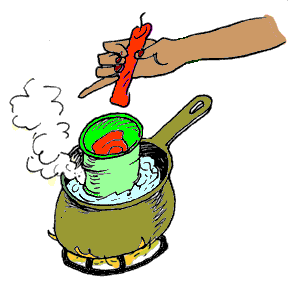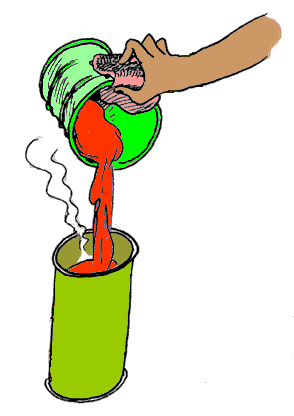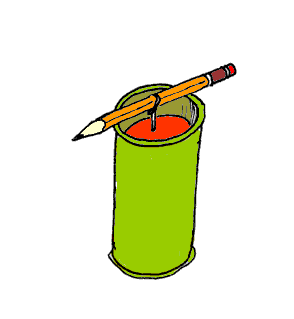| It's
a good idea to cover your work area with newspaper or waxed paper--dried wax
can be difficult to remove from some surfaces. And don't plan on pouring wax
over your kitchen sink--if you spill the wax, it'll stop up the drain. Be
aware that wax is flammable at high temperatures. Wax while it is heating should
never be left unattended.
Note:
It should also never be heated to the point that it sputters or smokes.
If
it should catch fire, cover it with a lid and turn off the stove. Never pour
water on a wax fire. Prepare
a mold Professionals
use precise, expensive molds made from very durable materials, but you don't
have to. You can create a mold with a variety of disposable food or beverage
containers that you can reuse and give a new usefulness. Some guidelines: - Make
sure
the
mold has a mouth that's wider than the base so your candle can slide out easily.
- Oil
the inside of the mold
with
vegetable oil. This will allow for easy removal--you don't want to have to
gouge out your newly wrought creation.
- Don't
use soup cans--they
have ridges that will prevent the removal the finished candle.
Set
up your double boiler Wax
should never be heated directly in a pot; instead always heat wax indirectly
with a double boiler. Since wax can be difficult to remove from pots, you'll
probably want to improvise a double boiler with a coffee can in a pot of water. - Put
a medium-sized pot
on
the stove, filled with a couple of inches of water, on high heat.
- Place
a
clean coffee can in the water while it is heating.
- There
should always be some water in the pot,
but
not so much that it floats the can around. Eventually the combined weight of
the can and the wax will be heavy enough to keep the can from bouncing around
in the water.
Melt
the paraffin (Wax)
 While
your water is warming up, you can start placing the wax in the coffee can.
If you prefer, you may use old candles, or a combination or paraffin and old
candles. While
your water is warming up, you can start placing the wax in the coffee can.
If you prefer, you may use old candles, or a combination or paraffin and old
candles.
- Measure
the wax:
figure 1/4 pound of wax per orange juice container.
- Cut
up the paraffin into small chunks, and
place it in the can. If you're using old candles, choose colors that will mix
well. You'll also want to remove any charred wick ends.
- Stir
with
an old spoon or Popsicle stick. If there are any old candles in the mix, take
a fork and pull out any old wicks that have been freed from the old candles.
Color
the wax (Optional) Crayons
are the best way to color candles. One candle per 1/4 pound of wax provides
a deep, rich color. Mix different colored crayons and see what you can come
up with. Combining half of a white crayon in with half of a colored crayon
makes a softer color. Nice effect! - Break
crayons into small pieces.
- When
the wax is nearly melted, drop the crayons into the coffee can.
- Stir
to mix color thoroughly.
Make
your own wicks - Cut
thick cotton string about three inches longer than your mold will require.
- When
your wax is melted, dip cotton string in wax.
- Hang
your wicks from a clothesline or place them on waxed paper, being sure to lay
them out in a straight line so you'll have nice straight wicks when you need
them later.
- Scent
your wicks: If you are making your own wicks, you have the option of scenting
the wicks rather than the candles. Before dipping wicks in wax, soak the wicks
in a fragrance or perfume
Pour
the wax 
Remove
the can from the boiling water. You'll want to use a pot holder or a kitchen
cloth for this. Let the wax cool for a minute or two before being poured into
the mold. - Tilt
the mold slightly, towards the can. This will improve the chances of neat,
spill-free transfer.
- Pour
wax slowly into the mold. Leave a little space at the top edge--it'll make
candle removal easier.
Insert
the wick
You'll
need a pencil to lay across the mouth of the mold in order to hold the wick
in place while the wax hardens. - Measure
the wick.
Take the wicks and lay them along the length of the mold. Add an extra 3/4
inch of string for the protruding section of wick, plus an extra inch or two
to wrap around the pencil.
- Insert
the wick
into
the center of the mold. Notice the amount of wick that remains outside the
mould. If you have an extra five inches, the wick hasn't reached the base of
the candle.

- Wrap
the
end of the wick around the pencil. This holds the wick in the center of the
wax while it cools.
Most
candles need at least a day before you remove them from the mold. Even though
your candle may look hardened, the wax inside is probably still not solid.
Don't rush the cooling process, or your fine efforts will be undone. Remove
the candle from the mold Be
patient while removing your candle, or it might be damaged by your hastiness. - For
paper molds
such
as a toilet paper core or a milk carton, simply tear the paper away from the
candle.
- For
molds of other materials,
try
turning the mold upside down and tapping the bottom of the mold.
- If
the candle doesn't slide out,
carefully
insert a knife between the candle and the mold. Jiggle the knife into that
space, prying very slightly (just a little bit) against the side of the mold.
If it still won't slip out, insert the knife into the opposite side of the
mold and do some more jiggling.
- If
your candle still won't budge, immerse
the mold in very hot water for a few seconds. This will slightly melt the outside
of the candle and it should slide out.
Insert
wick, method 2 Some
molds require that the wick be inserted after the wax is hardened and removed
from the mold, such sand mold candle a gelatin mold candle. - Remove
the
candle from the mold.
- Heat
an ice pick or a length of straight, thick wire--a
straightened wire hanger might work well here--over an open flame from a stove
or...a candle. If you're using a wire, be sure to wrap the end with a cloth
or hold it with a pot holder so you don't get burned.
- Insert
the heated pick or wire
through
the body of the candle. If it cools and stops melting the candle, simply reheat
it and continue melting through the candle.
- Insert
the wick
into
the hole you've just created.
- Pour
a small amount of melted wax
on
the top of the candle to secure the wick if it seems loose. Once the candle
is lit, any gaps between the wick and the body of the candle will be filled
in with melting wax.
|